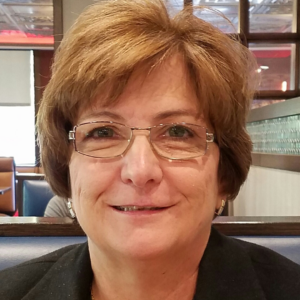Activities for Dementia Care: Unlocking What Remains
|
| Presiding over this group of residents, all in advanced stages of Alzheimer’s disease or other forms of dementia, is Samantha Porter, one of Menorah Park’s eight activities coordinators (each residential unit has its own coordinator). She points out that these Montessori-based activities [see the sidebar, “So Simple, It’s Genius,” for a detailed discussion of this approach] are not meaningless exercises aimed at merely keeping residents occupied, but they’re effective tools for improving and maintaining residents’ cognition and fine-motor skills through the use of familiar, everyday objects. “For example, the activity with the golf balls and the muffin tin allows residents to practice a motion similar to that of feeding oneself,” Porter explains. “And an activity like finding and grasping small objects such as coins can help maintain the fine-motor coordination involved in buttoning buttons while dressing oneself,” she adds. Porter points out that these activities also give residents a feeling of success. The activities are designed to be failure-free; none of them can be done “wrong.” If a square peg doesn’t fit into a round hole, so be it. It’s enough that residents are engaged in the activities and enjoying themselves. “What’s important is the process, not the outcome,” Porter emphasizes. Residents are permitted to choose which tasks they’re interested in on any given day, which gives them a feeling of independence and a sense of ownership. But because Porter, who has overseen activities at Menorah Park for three years now, is so familiar with the individual residents’ capabilities, she might gently guide them toward an activity that will give them the greatest feeling of accomplishment-preventing frustration with too difficult a task or boredom with one that is too simple. And she helps residents by giving them more complex projects once they’ve completed simpler ones. True to Montessori principles, they go at their own pace because rushing them would cause frustration and, perhaps, agitation. An aspect of the Montessori-based approach to working with residents that helps with cognition is the repetition of activities. Porter shows residents once how to complete a task and then, if they need help, reminds them how to do it the next time and the next, until they can tackle it without her assistance. With repetition, the residents learn how to do the activity instinctively, even though they might not consciously remember all the steps in the process. Some of the activities are useful for evoking memories, such as one in which laminated magazine photos of smiling or frowning people are matched with cards that say, in extra-large letters, “HAPPY” or “NOT HAPPY.” “For example, seeing a photo of a laughing baby during this activity can prompt residents to talk about their children when they were babies,” says Porter. The photos being used in this activity were selected by Jim (figure 2), a resident from this unit who isn’t with the group today because he’s enjoying time with a visitor. Giving residents opportunities to help other residents is a key Montessori principle, Porter explains. Just as the older children in a Montessori classroom enjoy serving as mentors for younger children, the higher-functioning residents derive great satisfaction from assisting others. In fact, Porter says that when residents are reluctant to participate in activities, they often change their minds when she asks for their help, noting that they respond to this approach much more readily than if she were to simply give them a task and say, “Here, do this.” |
| Activities for the more cognitively intact residents can be more complex. One of these is called Question-Asking Reading, in which a resident can read to a group from a simple story or fact sheet-Montessori mentoring in action again. At the end of the story or fact sheet are questions about what was just read, designed to stimulate discussion and socialization. Porter says, “Some people have the misconception that individuals with Alzheimer’s can’t read, but that’s often not the case. It’s the ‘first in, last out’ principle, meaning that the things people learned earliest in life are often those they retain the longest.” I notice this principle in action later, when Milton politely raises his hand to get Porter’s attention after he’s completed his task. It occurs to me that this is how he most likely learned to signal his teacher when he was a young boy in school. Another of the more advanced activities is a game that combines the memory skills of the game Concentration with boards like those used in a game of bingo. The group leader, either a member of the activities staff or one of the residents, holds up a card that says, for example, “You are my __________.” All those who have the word “sunshine” in a square on their boards say the word and pull a tab to mark that square. This often leads to a spontaneous sing-along. As Porter finishes explaining the memory game to me, I hear a tiny voice behind me saying, “Samantha, I have some Js and Rs. And, oh! I have lots of Es.” Madeline has continued her diligent sorting and has more stacks of letters ready to be put into bags for others to use in arts and crafts projects later. I compliment her on doing such a great job, and she grins and nods graciously. Porter gives Madeline a hand with bagging the letters and then moves on to offer encouragement to other residents or, if asked, to help with a task. She moves among them comfortably, and it’s obvious that they’re comfortable with her, too. She knows when to offer help and when to hang back and allow residents to try to complete an activity on their own. I’ve noticed during my visit to this Alzheimer’s unit at Menorah Park that, as is true of most parties, not all the “party goers” today are of the “dancing and wearing a crazy party hat” variety, but that that’s okay. Although most of the residents are involved in one of the activities, a few choose to simply sit and watch. And although they aren’t actively participating, it shows on their faces that they are engaged in their own way-in being with their peers and enjoying the buzz of activity surrounding them. As I’m putting on my coat and preparing to leave, I smile at Jenny, a silent, sweet-faced woman whose eyes have connected with mine several times during my visit. She returns my smile with a twinkle in her eye and a little wave of her hand. Her expression seems to convey, “Yes, I’m in here. Thank you for noticing. I wish you well.” While making my way across town through the slippery, slushy streets to return to my office, reflecting on all that I’ve just observed, I recall something that Dr. Cameron Camp, the director of Menorah Park’s Myers Research Institute [see sidebar], said to me a few days earlier. I had asked him if residents in the later stages of Alzheimer’s disease could still benefit from Montessori-based activities. He replied, “There’s always something we can do. Even if a person is comatose, we can still let her smell her favorite perfume, or we can let him feel the sensation of silk on his skin. We can talk in a soothing voice. If people are alive, we want to work with them. We always ask, “What remains?” I’ve seen that “what remains” for one person might be the skill and diligence to sort pile after pile of red and blue and green and yellow letters; and “what remains” for another person might be the simple ability to derive pleasure from being with others in a safe, positive, comfortable environment. I remember once again that the important thing is never to forget that each individual who has dementia-regardless of his or her cognitive ability and/or ability to communicate verbally-is, nonetheless, still a person. The Montessori approach acknowledges each resident’s uniqueness-and capitalizes on it-by allowing tasks to be individualized for those who engage in them. I’ve seen that this no-pressure, failure-free, self-directed approach creates a peaceful, nurturing environment. Not one person in the group of about 15 people I’ve just observed-each of them in advanced stages of dementia-became agitated during my visit. No one appeared to be frightened or frustrated or anxious. The atmosphere was one of “emotional comfort.” I feel it, too. Being with this group of people has been like a warm, soothing cup of cocoa to my soul, a respite from the wintry storm outside. Some days I wouldn’t trade jobs with anyone. This has been one of those days. Menorah Park is a continuing care retirement community located in Beachwood, Ohio. For more information, e-mail Deborah Kulber, Director of Public Relations, at dkulber@menorahpark.org or visit www.menorahpark.org. To send your comments to the author and editors, please e-mail zinn0205@nursinghomesmagazine.com. To order reprints in quantities of 100 or more, call (866) 377-6454. |
|
I Advance Senior Care is the industry-leading source for practical, in-depth, business-building, and resident care information for owners, executives, administrators, and directors of nursing at assisted living communities, skilled nursing facilities, post-acute facilities, and continuing care retirement communities. The I Advance Senior Care editorial team and industry experts provide market analysis, strategic direction, policy commentary, clinical best-practices, business management, and technology breakthroughs.
I Advance Senior Care is part of the Institute for the Advancement of Senior Care and published by Plain-English Health Care.
Related Articles
Topics: Activities , Alzheimer's/Dementia , Articles











